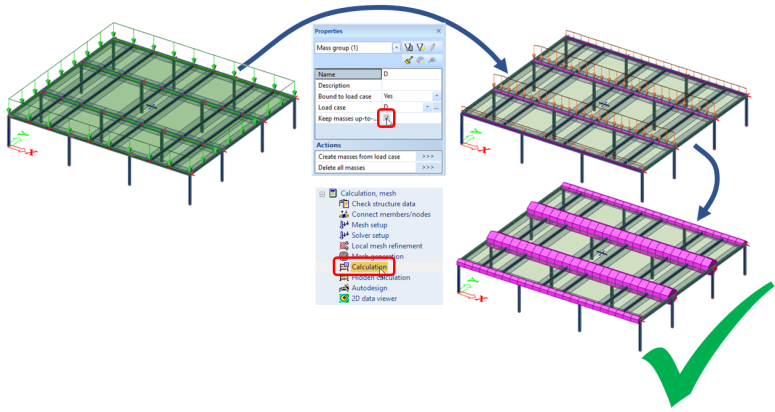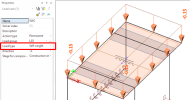Using diaphragms in dynamic analysis
Introduction
One important use of diaphragms is the analysis of the structural behaviour of buildings under lateral loading, in particular seismic loading.
In SCIA Engineer, dynamic and seismic analysis (including ELF method) requires the definition of masses. Masses may be defined manually or by converting gravity loads into masses. SCIA Engineer always takes into account the self-mass of the structure. However, it is necessary to refine that last statement for composite & metal decks.
The self-weight is the action of gravity on the self-mass. By default, the self-weight is a load acting in the vertical direction downwards, equal to the self-mass multiplied by the acceleration of gravity. However, although linked, both quantities are stored separately in SCIA Engineer and may be altered separately as well.
Manual input of masses on diaphragms
As a general rule, masses defined directly attached to diaphragms cannot be taken into account in the analysis model and are subsequently not exported to the solver when running the dynamic calculation. The reason for that is, that masses are usually acting equally in all directions.
In the case of a rigid diaphragm, there is no FE mesh inside the surface of the diaphragm, as the diaphragm behaves like a rigid link that connects all the nodes of its supporting members. That means, that a uniform surface mass cannot be considered directly on the surface, because the surface just doesn't exist in the analysis model.
In the case of a semi-rigid or flexible diaphragm, the FE mesh exists, but without any bending stiffness. Therefore, a uniform surface mass would not be held in the direction perpendicular to the plane of the diaphragm, causing large, irrelevant displacements in that direction or even a singularity in the analysis.
As a consequence, masses must be redistributed to supporting entities (e.g. beams), in the same way as loads. Diaphragms use the load panel functionality to transfer loads to the supporting beams. However, that functionality is designed to redistribute only loads, not masses.
The procedure for defining masses on diaphragms is, nevertheless, straight forward, as, in most cases, masses for the dynamic analysis are deducted from the static loading of the structure:
- use only mass groups linked to a load case
- make sure that the option Keep masses up-to-date is ticked ON in the properties of the mass group
- if masses must be defined manually, make sure that they are attached to supporting members instead of diaphragms
Enabling the Keep masses up-to-datesetting causes the loads to be converted to masses after being distributed to the supporting members of the diaphragm (or load panel). Typically, line loads on beams are converted to line masses on beams, instead of the initial surface load applied on the diaphragm or load panel.
Self-weight and mass of structural members
Non-composite members
Non-composite members also include the steel profile of composite beams.
The self-weight of non-composite members is taken into account in one operation, through a self-weight load case. That load case contains the entire self-weight of such members.
The self-mass of non-composite members is taken into account automatically during dynamic analysis. SCIA Engineer includes the self-mass in each mass combination without intervention of the user.
A self-weight load case contains no explicit load for non-composite members. As a consequence, linking a mass group to a self-weight load case will produce only an empty mass group.
Both self-weight and self-mass of non-composite members may be altered, separately, using property modifiers.
Composite & metal decks
The mass and self-weight of composite decks is made of 3 components:
- the profiled steel sheeting
- the fresh concrete
- the dry concrete
For metal deck, the concrete parts are simply left out, but the other principles remain.
By default, partial self-weight is enabled for composite decks, which means, that different density values are used for concrete, depending on the considered check. For construction stage checks, the steel sheeting and fresh concrete are used. For final stage checks, the steel sheeting and dry concrete are used. Separate, partial self-weight load cases are used for the 3 parts listed above.
The partial self-weight feature may be disabled in the composite setup. In that case, only the dry density of concrete is considered in all cases for the analysis. Only one, standard self-weight load case is then used, which contains the self-weight of the entire structure, including composite & metal decks.
In all cases, the self-weight loads are explicitly generated for all composite & metal decks. Those surface loads are visible in the self-weight load cases (partial or not).
The table below summarizes the possible use cases and what loads are generated.
| 2D member type | Partial self-weight enabled | Load case | Generated surface loads |
| Standard | irrelevant | SW | none |
| Composite deck | yes | SW | self-weight of steel sheeting |
| SW_fresh | self-weight of fresh concrete | ||
| SW_dry | self-weight of dry concrete | ||
| no | SW | self-weight of deck (sheeting+dry concrete) | |
| Metal deck | yes | SW | self-weight of steel sheeting |
| SW_fresh | none | ||
| SW_dry | none | ||
| no | SW | self-weight of steel sheeting |
Notations:
- SW = standard self-weight load case
- SW_fresh = partial self-seight load case with fresh concrete density
- SW_dry = partial self-weight load case with dry concrete density
In the case of a 2D member with type Standard, no explicit load is generated. Instead, the thickness and density values of the 2D member are sent to the solver, which then calculates the corresponding self-weight load.
Taking self-weight & mass into account in the analysis
For composite decks and metal decks, it is necessary to create and include in the mass combinations mass groups linked to relevant self-weight load cases. Doing so, SCIA Engineer can, if needed, transfer the generated surface loads to the supporting beams, which, in turn, will be converted to masses for the dynamic analysis.
For all other types of members, the self-mass is automatically taken into account in any dynamic analysis.
Use case A
- the model contains at least one composite deck and
- partial self-weight is enabled
Carrying out a dynamic analysis requires that you:
- create a mass group, linked to SW load case, with automatic update of masses enabled
- create a mass group, linked to either SW_fresh or SW_dry load case, with automatic update of masses enabled
- insert both created mass groups in the mass combination(s) to be used
Make sure to use either a mass group linked to SW_fresh or a mass group linked to SW_dry in a mass combination. Using them together in the same mass combination would double the mass of concrete of the composite deck.
Use case B
- the model contains at least one metal deck and
- the model contains no composite deck or partial self-weight is disabled
Carrying out a dynamic analysis requires that you:
- create a mass group, linked to SW load case, with automatic update of masses enabled
- insert the created mass group in the mass combination(s) to be used
Use case C
- the model contains neither a composite deck nor a metal deck
No particular action is required when defining the masses for a dynamic analysis. All self-mass is included automatically in the dynamic calculations.
When running a dynamic analysis of a composite structure, SCIA Engineer checks the consistency of mass groups. In case some inconsistency is detected, a warning message is displayed. It is possible to ignore it (for special cases, when, for instance, masses are defined entirely manually).




